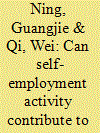| Srl | Item |
| 1 |
ID:
156467


|
|
|
|
|
| Summary/Abstract |
The ascension to urban citizenship and assimilation into urban life for rural to urban migrant workers is a pressing mission during the current process of rapid urbanization in developing China. However, the issue of how self-employed migrants, who account for up to 25 percent of total migrant workers in 2009 (Meng, 2012), acquire urban citizenship remains understudied. Using a unique sample from the 2009 Rural to Urban Migrants in China (RUMiC) survey, this paper explores whether self-employment choice contributes to migrant workers' ascension to urban citizenship and integration, and uncovers the underlying mechanisms. We find that although self-employed migrants are capable of earning a higher income, and improving their living conditions, their tendency to reside permanently in the city is not significantly different from their counterparts of wage workers. We argue that self-employed migrants, who are less covered by urban social securities and are more discriminated against by current urban household registration (Hukou) system, tend to lose faith in ascension to urban citizenship. It implies that a social security system with self-employed migrants being covered as well as an urban Hukou admission system favoring diverse human capital (especially taking into account entrepreneurship) would help accelerate the urbanization process.
|
|
|
|
|
|
|
|
|
|
|
|
|
|
|
|
| 2 |
ID:
169849


|
|
|
|
|
| Summary/Abstract |
Population migration embodies virtual residential energy consumption and carbon transfer from the origin to the destination. Based on the differences of the per capita levels between the sending-out origins and arriving-in destinations, we develop a model to estimate the inter-spatial transfer flows of residential carbon emissions, broken down by rural-to-urban, rural-to-rural, urban-to-rural and urban-to-urban flows. The net value of transfer-in and transfer-out residential carbon emission contributes to the change of the whole carbon emission. Using the latest census data and energy balance sheet in 2010, China's inter-provincial residential carbon emission flows embedded in the population migration were calculated and visualized. We found that China's non-Hukou migration increased the national total residential carbon emission. The largest transfer flows were mainly from central to eastern China. The northern provinces were also distinct destinations due to the high-carbon energy structure. The regional difference of residential energy consumption structures, the unbalanced regional economic development and origin-to-destination interaction were the main influencing factors. To promote low-carbon and environment-friendly urbanization, the energy optimization policy should be enhanced in the identified regions, especially in the Beijing-Tianjin area.
|
|
|
|
|
|
|
|
|
|
|
|
|
|
|
|